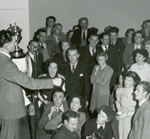Life in New Zealand
An official from the Labour Department gives employment advice to new arrivals on the Monowai, 1949.
A gathering at the Wellington club rooms of the New Settlers’ Association.
The 'six o'clock swill' at the Porirua Tavern in 1967.
After they arrived, each assisted immigrant was given a letter of welcome from Bert Bockett, the Secretary for Labour, which outlined the assistance which the Department would give them and provided details of the jobs in New Zealand to which they had been appointed, along with their transport and accommodation arrangements.
In return for their passage, migrants agreed to work for two years in a job allocated to them by the Labour Department. They could change jobs, but only with the permission of the Department—many, however, changed first and asked afterwards which the Department did not encourage but was increasingly prepared to accept in the later years of the scheme.
New Settlers' Associations began to be established in 1948. Their aim was to promote social contacts and closer ties of friendship between new arrivals and new Zealanders, and 'to help each one of us keep in contact with one another.' There were branches throughout the country and a club magazine which was produced in Wellington.
Many immigrants appreciated the lifeline the Association offered when the shock of living in New Zealand was difficult to cope with. As one correspondent wrote in 1949,
I tried to keep an open mind, but it was all rather strange, so different from anything I had experienced. I was born and bred in the centre of London, I felt lost here—so few people, such small houses, so many wide open spaces, so little organized entertainment.
The Association held dances and organised activities which reflected the interests of members—musical appreciation, tramping and soccer amongst others.
New Zealand’s 'six o’clock swill' came as a shock to those used to the more civilised licensing hours of the United Kingdom. City public bars, in particular, were not places where one would want to spend too much time.
One man wrote about hotels he visited in Wellington in 1953 that had concrete floors,
no tables or seating, no ashtrays, just little shelves at shoulder height where you could place your glass if you were near a wall. Little wire and wooden baskets which could hold six glasses were passed over to the barman for a refill. He passed his hose over the top of them and charged 6d a glass.
Depending on your attitude, such bars were either revolting or ‘joyfully appalling’. After a referendum in 1967, opening hours were extended to 10 p.m.
Next: Film and Sound files >
Further Reading
Related immigration links on Te Ara - The Encyclopedia of New Zealand
- History of immigration
- Immigration regulation
- Immigration entry from the 1966 Encyclopaedia of New Zealand


